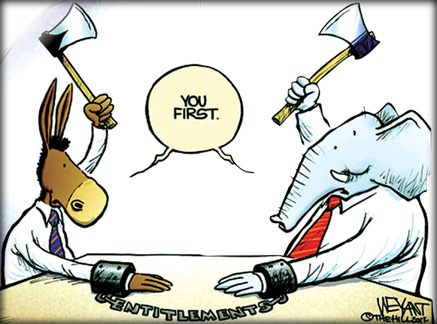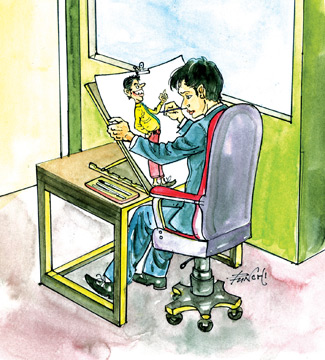|
Political cartoons:
Resurgence regales viewers
By Kalakeerthi Edwin Ariyadasa
“In an outburst provoked by a political cartoon, in the issue of the
US publication Harpers Weekly on August 19, 1871, political Boss William
Marcy Tweed spluttered. “Stop them damn pictures. I don’t care so much
what the papers write about me. My constituents cannot read. But, damn
it, they can see pictures.”
 In recent years in Sri Lanka, the political cartoon has emerged into
ultra-high profile. This is not a phenomenon that has been foreseen by
many. But, it is true, that the popularity of the political cartoon, has
surged in a swift upward curve, lately, in a manner that has surprised
most observers. In recent years in Sri Lanka, the political cartoon has emerged into
ultra-high profile. This is not a phenomenon that has been foreseen by
many. But, it is true, that the popularity of the political cartoon, has
surged in a swift upward curve, lately, in a manner that has surprised
most observers.
This new and proliferating mass interest in the political cartoon, in
our day, was wittily emphasised by a celebrated ‘victim’ of this medium.
This distinguished victim Media Minister Keheliya Rambukwella, affably
recorded that, he could possibly be the foremost among those, who are
regularly made the targets for their sharp barbs by political
cartoonists.
The VIP victim, confessed with an admirable graciousness, which was
not marred, even by a stray trace of rancour, that he is mostly depicted
as a laundryman either carrying a bag of soiled clothes or being busy
washing dirty linen.
Prominence
When you think about it, the political cartoon, has suddenly evolved
into an unprecedented social prominence.
It has transited from the print medium – its original home – into a
multiplicity of television channels. At first, the pioneering television
channels, merely introduced the day’s political cartoons, with only a
modicum of commentary.
But, when a competition set in among television programs featuring
political cartons, the total atmosphere underwent a strange change. The
presentation of the political cartoon, took on the guise of a dramatic
enactment.
Spirit
Today, of a morning, you can see some presenters, who interpret the
spirit of a political cartoon, laughing, guffawing and gesticulating as
if they are actors in a stage performance.
In addition, some of them add their own comments, in an effort to
drive a point home with a sharper tang.
The television incarnation of the political cartoon is a relatively
recent development. About five years ago, the television feature titled
Mulpituwa, while presenting excerpts from the day’s newspapers, began to
regale the viewers with a soul-tickling feast of political cartons.
The day’s yield of the ‘barbed art’ will arrive home via the small
screen, early each morning, as a sustaining electronic breakfast.
At first, Mulpituwa, was more or less a monopoly.
With the passage of time, as this feature proved a singular mass
pleaser, emulators started taking the stage, in a profusion of similar
programs.
The outcome of all this is today, of a morning, the small screen
becoming a crowded domain of all those presenters, who are keen to grab
a slice of this strange popularity of the political cartoon, as it takes
up its position in the television news shows.
In the early days, it was rather rarely that a political cartoonist
would be known by the news consuming masses. But, strangely enough,
currently, not only the cartoonists but even the characters they create,
get readily embedded in the folk memory.
Escapades
The viewers of the news surveys on television follow the escapades of
their favourite cartoon - heroes, with an avidity, that is baffling.
In the first instance, their addiction to the political cartoon, is
determined perhaps by the simple fact, that it is easier to absorb the
implication of a political cartoon, than tediously ploughing through an
extensive printed text, to get to know what is going on. Besides, the
caricatured personalities, are for more interesting, than those
described in the written word.
In classical Greek tragedy, the torments endured by the tragic hero,
enable the spectators to achieve cathartic release, vicariously through
the privations of those victims of destiny.
In our day, the people are sorely troubled by daily vexations.
 They are irked by sundry frustrations, brought on by quotidian
disappointments. Under ordinary circumstances, the fury generated by
such soul-searing experiences will be converted into acts of irrational
violence. They are irked by sundry frustrations, brought on by quotidian
disappointments. Under ordinary circumstances, the fury generated by
such soul-searing experiences will be converted into acts of irrational
violence.
But, the political cartoons make the people acquire a cathartic
release, without allowing their inner pangs to come out in the form of
violent external acts.
The spectators get addicted to political cartoons, as they allow them
to find relief for their own vexations.
The efficiently crafted political cartoon, enables the troubled
spectation, to laugh their pains off, and to derive, at least a modicum
of satisfaction, seeing how the cartoonists aim their barbs at those in
the higher echelons of social structure.
Leaders of Sri Lankan society have always displayed a praiseworthy
and admirable capacity to accept the barbs of their ‘tormentors’ with
equanimity and grace.
Current leaders of Sri Lanka, have always extended an appreciative
friendliness towards the cartoonists, who portray them in all forms of
shapes and appearances.
This amiable patronage to the cartoonists, sends out a wholesome
message – loud and clear. We are democratic. We uphold cherished values
of human nobility. Al is well with our democratic ideals.
But, the Media Minister will have to be always alert to how his
friendly tormentors will caricature him. |

